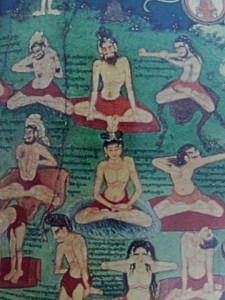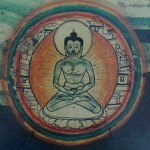ANUYOGA – TIBETAN STUDIES CONFERENCE

Tibetan Studies, Conference, 2010, Tsering, Shakya
Anuyoga (Skt. अनुयोग ‚further yoga‘) is the designation of the second of the three Inner Tantras according to the ninefold division of practice used by the Nyingma school of Tibetan Buddhism. As with the other yanas, Anuyoga represents both a scriptural division as well as a specific emphasis of both view and practice. Read More: > HERE <
Modern-day doxographical presentations of the Nyingma school are usually based on the system of the nine vehicles (theg pa dgu). Emphasis is placed on the highest three vehicles in this scheme, namely MahÄ�yoga, Anuyoga, and Atiyoga. Generally speaking, these three “inner” yogas correspond to three stages in tantric practice, namely the generation stage, during which the details of the visualizations are stabilized, the perfection stage, in which those visualizations are then employed towards familiarizing oneself with the state of enlightenment, and finally the Great Perfection, the spontaneous accomplishment of buddhahood. Being the second of the three inner yogas, Anuyoga is thus associated with the practices of the perfection stage.
The perfection stage practices are often divided into those without signs (mtshan med) and those with signs (mtshan bcas). The former refer to practices in which the enlightened view is accomplished instantaneously, without any effort, “like a fish leaping out of the water.” The latter – the practices with signs – are generally the perfection stage practices known collectively as “channels and winds” (rtsa lung). Here, the practitioner works with a system of channels within one’s body, through which are moving the “winds” – subtle energies closely related to one’s mind. (Quelle THLIB)

The Nyingma tradition is a complex of many lineages and teachings, including dzogchen. Let us examine some of its major facets.
The Nyingma (Old Translation Period) tradition divides Buddha’s teachings into nine vehicles (theg-pa dgu): three sutra and six tantra. This contrasts with the Sarma (New Translation Period) schools of Kagyu, Sakya, and Gelug, which divide the teachings into three sutra and four tantra vehicles.
- The three sutra vehicles are the shravaka, pratyekabuddha, bodhisattva vehicles. The first two are in the category of Hinayana, while the latter is Mahayana.
- The three outer tantras are kriya, charya, and yoga.
- The three inner tantras are mahayoga, anuyoga, and atiyoga or dzogchen.
- [See: The Terms Hinayana and Mahayana. See also: Basic Features of Tantra.]
The first six vehicles in Nyingma and Sarma are the same. The three Nyingma inner tantra vehicles are roughly equivalent to the Sarma category of anuttarayoga tantra. This is because both categories deal with a subtler level of mental activity (mind) than the lower vehicles do for actualizing the third and fourth noble truths – true stoppings of the first and second noble truths (suffering and its causes) and the true pathways of mind that bring about and have true stoppings. True causes are confusion about reality (unawareness, ignorance) and the fleeting levels of mental activity at which they operate. Because they are fleeting levels, they can be removed.
Maha, Anu, and Atiyoga in Comparison with Father, Mother, and Nondual Anuttarayoga Tantra – Mahayoga, anuyoga, and atiyoga all contain the same basic elements of practice on the tantra path to enlightenment. They differ in terms of emphasis. The same distinction is true concerning the three divisions of anuttarayoga tantra: father, mother, and nondual tantra. The two division schemes, however, are not equivalent.
The practice of anuttarayoga tantra entails the generation stage (bskyed-rim) and the complete stage (rdzogs-rim, completion stage). On the generation stage, we generate ourselves as Buddha-figures merely with the power of our imaginations (visualization). On the complete stage, everything is complete for actually generating the immediate causes for the body and mind of a Buddha – not just in our imaginations.
On the complete stage, we cause the energy-winds (rlung, Skt. prana) to enter, abide, and dissolve in the central channel. This enables us to access the subtlest level of mental activity (clear light, ‘ od-gsal) and use it for the nonconceptual cognition of voidness – the immediate cause for the omniscient mind of a Buddha. We use the subtlest level of energy-wind, which supports clear light mental activity, to arise in the form of an illusory body (sgyu-lus) as the immediate cause for the network of form bodies (Skt. rupakaya) of a Buddha.
Within this scheme of anuttarayoga tantra:
- father tantra emphasizes illusory body practice,
- mother tantra emphasizes clear light practice,
- nondual tantra emphasizes the unified pair (zung-’jug) of illusory body and clear light.
If we use the same scheme as in anuttarayoga to analyze the Nyingma presentation, and divide the complete stage into two phases – before attaining actual clear light nonconceptual cognition of voidness, and after, when we attain the immediate cause for a rupakaya – then:
- mahayoga emphasizes the generation stage,
- anuyoga emphasizes the first phase of the complete stage and working with the energy-winds, channels, and chakras,
- atiyoga (dzogchen) emphasizes the second phase of the complete stage, at which we actualize the immediate causes for the enlightening mind and form bodies of a Buddha.
- READ FULL ARTICLE > HERE <:
Comments are closed.